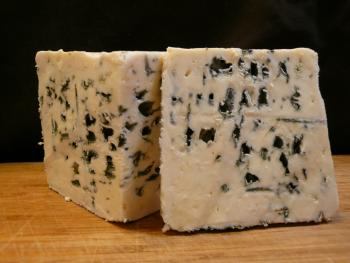Roquefort
- Producer
- Various
- Country
- France
- Region
- Aveyron
- Size
- 8 ins diameter, 4 ins high
- Weight
- 6-8lbs
- Website
- Milk
- Sheep
- Treatment
- Raw
- Classification
- Semi Soft
Blue - Rennet
- Animal
- Rind
- Foil Wrap
- Style
- Blue

An AOC designated cheese, Roquefort is made specifically from the milk of the Lacaune breed of sheep. It is produced throughout the regions of Aveyron and part of the nearby départements of Lozère, Gard, Hérault and Tarn, in southern France.
This is an area famous for its limestone geology, which dictates the species of grass and wildflowers that grow upon it, and thus influences the taste of the milk.
The mold that gives Roquefort its distinctive character (Penicillium roqueforti) is found in the soil of the local caves. Traditionally the cheesemakers extracted it by leaving bread in the caves for six to eight weeks until it was consumed by the mold. The interior of the bread was then dried to produce a powder. Nowadays the mold can be produced in a laboratory, which allows for greater consistency.
There are just a handful of Roquefort producers. The largest by far is Roquefort Société, made by the Société des Caves de Roquefort (a subsidiary of Lactalis), which owns several caves and allows public visitors. Roquefort Papillon is also a well-known brand. Other producers include Carles, Gabriel Coulet, Fromageries Occitanes, Vernières and Le Vieux Berger.
Tasting Notes
The interior paste of Roquefort is white, crumbly and slightly moist, with distinctive veins and pockets of blue mold. Wheels do not grow a rind, rather they are wrapped in foil. They have a distinctive aroma and flavors of sweet butter, caramel, smoke and salt, offset by the tangyness of the blue mold.
Pairings
Roquefort pairs well with a sweet dessert wine such as Sauternes or an Alsacian white.



